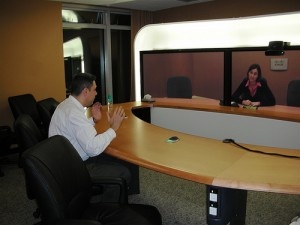Two Biggest Hotel Chains Explore New Industry Move into Teleconferencing

I like it when a business doesn’t define itself too narrowly. So it’s a round of applause this morning for Starwood Hotels and Resorts and Marriott International as they get into the teleconferencing game.
Yes, you read that right. Hotels, which traditionally have made their money by luring executives to meet face to face in their conference rooms, and thus stay overnight in their rooms, are now saying it’s OK to stay home. Instead, the profit stream comes from renting a high-tech telepresence room to talk to colleagues around the world.
Executives get a break twice: first in the obvious travel costs and second by sidestepping the need to purchase the telepresence equipment themselves. According to reports, it costs roughly $500 an hour to rent a technology room at these hotel chains, which is a far cry richer than the $259 per night with less labor. Of course, they’re missing the chance to grab an extra $12 for Internet connection and $30 on parking.
Starwood and Marriott are eyeing a shot at events like job interviews, legal depositions and smaller meetings. Starwood has targeted its properties in New York, Sydney (Australia), Toronto, Los Angeles and Chicago for the telepresence capabilities; Marriott, too, will launch the service in New York with 24 more to follow in San Francisco, Washington, Hong Kong, Shanghai, Frankfurt and London. They are both working with Cisco on the sophisticated conference rooms.
“As the 24/7 world economy becomes more interconnected, the need to hold small global meetings that cross continents and oceans will only grow,” says Arne Sorenson, president and COO, Marriott International. “We believe telepresence will create more business meetings because people can travel shorter distances and easily connect with colleagues and clients around the world. The addition of telepresence meeting suites in our hotels will give Marriott a leg up on its competition.”
ADVERTISEMENT
Starwoods’ response: “Because of the decentralized nature of business today, without public room deployments, telepresence can never achieve the critical mass needed to realize the full potential of this exciting video technology.”
Meanwhile, according to the New York Times, American Express and Carlson Wagonlit Travel want to jump in by offering consulting services to help business clients decide when to rent a telepresence suite and when to take the old-fashioned “get a room” approach.
I guess thinking outside the box is contagious.
Photography: edans (Flickr)

